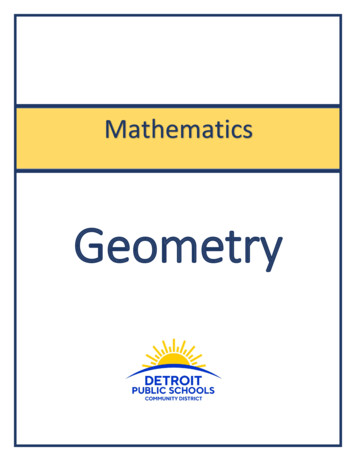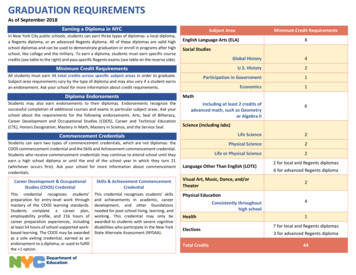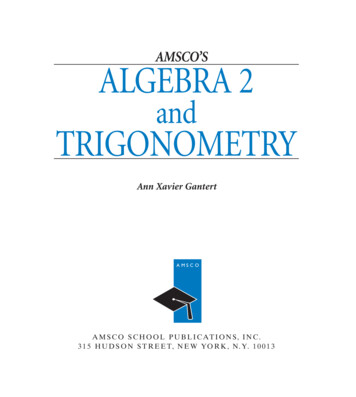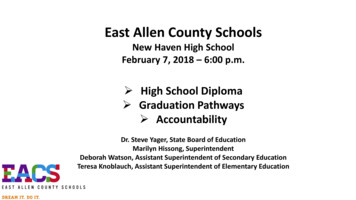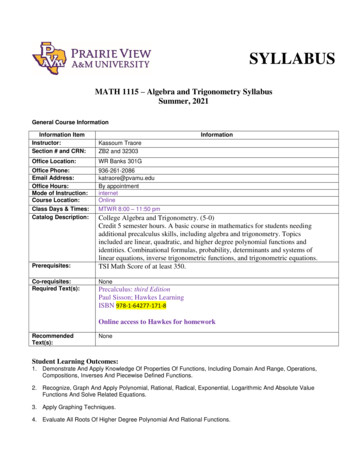
Transcription
SYLLABUSMATH 1115 – Algebra and Trigonometry SyllabusSummer, 2021General Course InformationInformation ItemInstructor:Section # and CRN:Kassoum TraoreZB2 and 32303Office Location:WR Banks 301GOffice Phone:Email Address:Office Hours:Mode of Instruction:Course Location:936-261-2086katraore@pvamu.eduBy appointmentinternetOnlineClass Days & Times:Catalog Description:MTWR 8:00 – 11:50 pmPrerequisites:Co-requisites:Required Text(s):InformationCollege Algebra and Trigonometry. (5-0)Credit 5 semester hours. A basic course in mathematics for students needingadditional precalculus skills, including algebra and trigonometry. Topicsincluded are linear, quadratic, and higher degree polynomial functions andidentities. Combinational formulas, probability, determinants and systems oflinear equations, inverse trigonometric functions, and trigonometric equations.TSI Math Score of at least 350.NonePrecalculus: third EditionPaul Sisson; Hawkes LearningISBN 978-1-64277-171-8Online access to Hawkes for homeworkRecommendedText(s):NoneStudent Learning Outcomes:1. Demonstrate And Apply Knowledge Of Properties Of Functions, Including Domain And Range, Operations,Compositions, Inverses And Piecewise Defined Functions.2. Recognize, Graph And Apply Polynomial, Rational, Radical, Exponential, Logarithmic And Absolute ValueFunctions And Solve Related Equations.3. Apply Graphing Techniques.4. Evaluate All Roots Of Higher Degree Polynomial And Rational Functions.
5. Recognize, Solve And Apply Systems Of Linear Equations Using Matrices.6. Solve Absolute Value, Polynomial And Rational Inequalities7.Compute the values of trigonometric functions for key angles in all quadrants of the unit circle measuredin both degrees and radians.8.Compute values of the six basic inverse trigonometric functions.9.Graph trigonometric functions and their transformations.10.Prove trigonometric identities.11.Solve trigonometric equations.12.Solve right and oblique triangles.13.Use the concepts of trigonometry to solve applications.14.Compute operations of vectors.15.Represent complex numbers in trigonometric form.Core Curriculum Learning Outcomes:16. Critical Thinking Skills17. Communication Skills18. Teamwork19. Empirical and Quantitative Skills20. Personal ResponsibilitySocial ResponsibilityCourse Grade Requirement1. Homework2. Exam13. Exam 24. Exam 35. Exam 48. Final ExamTotal**averageTotal15%15%15%15%15%25%100%
Tentative Instructional Outline:(A Tentative calendar must be included but you do not have to use this format. Please delete thiscomment before finalizing your syllabus.)1AssignmentsTopicsWeekNumberMethod of Instruction1Jul 07DueDate Sign-up forHawkes Course Syllabus 1.5 Complex Numbers Zoom Lecture 1.6 Linear Equations in OneVariable 1.7 Linear Inequalities in OneVariableRead Textbook or read PDffile on Canvas and practiceexample Watch Lecture video on Homework 1.5, 1.6& 1.7Canvas Jul 081.8 Polynomial andPolynomial-Like Equations inOne Variable1.9 Rational and RadicalEquations in One Variable Zoom Lecture Read Textbook or read PDffile on Canvas and practiceexample Watch Lecture video on Homework 1.8 &1.9Canvas2Jul 12 2.1 The Cartesian CoordinateSystem 2.2 Circles 2.3 Linear Equations in TwoVariables Homework 2.1 –2.3 Zoom Lecture Read Textbook or read PDffile on Canvas and practiceexample Watch Lecture video onCanvasHomework1.5 – 1.9Due Jul 11
AssignmentsTopicsWeekNumberMethod of Instruction 2.5 Parallel and PerpendicularLines 3.1 Relations and FunctionsJul 13 Homework 2.4 ,2.5, & 3.12.4 Slope and Forms ofLinear Equations DueDate Zoom Lecture Read Textbook or read PDffile on Canvas and practiceexample Watch Lecture video onCanvas 3.2 Linear Functions 3.3 Quadratic Functions 3.4 Other Common Functions Zoom Lecture Read Textbook or read PDffile on Canvas and practiceexample Watch Lecture video onJul 14 Homework 3.2 –3.4CanvasJuly 15 4.1 Transformations ofFunctions 4.2 Properties of Functions 4.3 Combining Functions Exam 1 Zoom Lecture Read Textbook or read PDffile on Canvas and practiceexample Watch Lecture video on Homework 4.1 –4.3 Exam 1: Chap1,2,3 & 4.1 –4.3Canvas3 Jul 19 4.4 Inverse Functions5.1 Polynomial Functions andPolynomial Inequalities5.2 Polynomial Division andthe Division Algorithm Zoom Lecture Read Textbook or read PDffile on Canvas and practiceexample Watch Lecture video on Homework 4.4,5.1, & 5.2CanvasJul 20 5.3 Locating Real Zeros ofPolynomials 5.4 The FundamentalTheorem of Algebra 5.5 Rational Functions andRational Inequalities Zoom Lecture Read Textbook or read PDffile on Canvas and practiceexample Watch Lecture video onCanvas Homework 5.3 –5.5Homework2.1– 2.5,3.1 – 3.4, &4.1 – 4.3Due Jul 17Exam 1Due July18
Method of Instruction Jul 21AssignmentsTopicsWeekNumber6.1 Exponential Functionsand Their Graphs Zoom Lecture 6.2 Exponential Models 6.3 Logarithmic Functionsand Their GraphsRead Textbook or read PDffile on Canvas and practiceexample Watch Lecture video onDueDate Homework 6.1 –6.3Canvas Jul 22 6.4 Logarithms Propertiesand Models Zoom Lecture Homework 6.4 &6.5 Read Textbook or read PDffile on Canvas and practiceexample Exam 2: 4.4,Chap 5 & 6 Watch Lecture video on6.5 Exponential andLogarithmic EquationsExam 2Exam 2Due Jul25Canvas4Jul 26 7.1 Radian and DegreeMeasure of Angles 7.2 Trigonometric Functionsand Right Triangles Zoom Lecture Read Textbook or read PDffile on Canvas and practiceexample Watch Lecture video on Homework 7.1 &7.2CanvasJul 27 7.3 Trigonometric Functionsand the Unit Circle 7.4 Graphs of Sine andCosine Functions Zoom Lecture Read Textbook or read PDffile on Canvas and practiceexample Watch Lecture video on Homework 7.3 &7.4CanvasJul 28 7.5 Graphs of OtherTrigonometric Functions 7.6 Inverse TrigonometricFunctions Zoom Lecture Read Textbook or read PDffile on Canvas and practiceexample Watch Lecture video onCanvasHomework4.4 Chap 5& Chap 6Due Jul 24 Homework 7.5& 7.6
AssignmentsTopicsWeekNumberMethod of Instruction 8.1 Fundamental Identitiesand Their Uses 8.2 Sum and DifferenceIdentities Exam 3Jul 29 Zoom Lecture Homework 8.1 &8.2 Read Textbook or read PDffile on Canvas and practiceexample Exam 3: Chap 7& 8,1, 8.2 Watch Lecture video onCanvasDueDateHomework7.1 – 7.4 &8.1, 8.2Due Jul 31Exam 3Due Aug015 8.3 Product-SumHhh Identities 8.4 Trigonometric Equations Zoom Lecture Read Textbook or read PDffile on Canvas and practiceexample Watch Lecture video onAug 02 Homework 8.3 &8.4Canvas 9.1 The Law of Sines Zoom Lecture 9.2 The Law of Cosines Read Textbook or read PDffile on Canvas and practiceexample Watch Lecture video onAug 03 Homework 9.1 &9.2CanvasAug 04 9.3 Polar Coordinates andPolar Equations 9.5 Trigonometric Form ofComplex Numbers Zoom Lecture Read Textbook or read PDffile on Canvas and practiceexample Watch Lecture video on Homework 9.3 &9.4Canvas 9.6 Vectors in the CartesianPlane 9.7 The Dot Product and ItsUses Exam 4Aug 05 Zoom Lecture Homework 9.6 &9.7 Read Textbook or read PDffile on Canvas and practiceexample Exam 4: 8.3,8.4 & Chap 9 Watch Lecture video onCanvas6Homework8.3, 8.4 &9.1 – 9.7Due Aug07Exam 4Due Aug08
Aug 09AssignmentsTopicsWeekNumberMethod of Instruction 11.1 Solving Systems bySubstitution and Elimination 11.2 Matrix Notation andGaussian Elimination Zoom Lecture Read Textbook or read PDffile on Canvas and practiceexample Watch Lecture video onDueDate Homework 11.1 &11.2CanvasHomework11.1 & 11.2Due Aug10Final Exam ReviewFinal Exam ReviewAug 10Final ExamAug 11FinalExam:Comprehensive
Course Procedures or Additional Instructor PoliciesTaskstreamTaskstream is a tool that Prairie View A&M University uses for assessment purposes. One of your assignmentsmay be required to be submitted as an "artifact,” an item of coursework that serves as evidence that courseobjectives are met. If applicable, more information will be provided during the semester by your department, but forgeneral information, you can visit Taskstream via the link in eCourses.Student Support and SuccessJohn B. Coleman LibraryThe library and its partners have as their mission to provide resources and instructional material in support of theevolving curriculum, as a partner in Prairie View A&M University's mission of teaching, research, and service and tosupport the University's core values of access and quality, diversity, leadership, relevance, and social responsibilitythrough emphasis on ten key areas of service. It maintains library collections and access both on campus, online,and through local agreements to further the educational goals of students and faculty. Phone: 936-261-1500;Website: J. B. Coleman Library.Academic Advising ServicesAcademic Advising Services offers students a variety of services that contributes to student success and leadstowards graduation. We assist students with understanding university policies and procedures that affect academicprogress. We support the early alert program to help students get connected to success early in the semester. Wehelp refer students to the appropriate academic support services when the student is unsure of the best resource fortheir needs. Some students are supported by faculty advisors in their respective colleges. Your faculty advisor canbe identified in PantherTracks. Advisors with Academic Advising Services are available to all students. We are locatedacross campus. You can find your advisor’s location by academic major at the Academic Advising Website, Phone:936-261-5911.The University Tutoring CenterThe University Tutoring Center (UTC) offers free tutoring and academic support to all registered PVAMU students.The mission of the UTC is to help provide a solid academic foundation that enables students to become confident,capable, independent learners. Competent and caring staff and peer tutors guide students in identifying, acquiring,and enhancing the knowledge, skills, and attitudes needed to reach their desired goals. Tutoring and academicsupport is offered face-to-face in the UTC, in virtual face-to-face sessions, and through online sessions at PVPlace.Other support services available for students include Supplemental Instruction, Study Break, Academic SuccessWorkshops, and Algebra Study Jam. Location: J. B. Coleman Library, Rm. 307; Phone: 936-261-1561; Email:pvtutoring@pvamu.edu; Website: University Tutoring Center.The Writing CenterThe Writing Center provides well-trained peer tutors that assist students with writing assignments at any stage of thewriting process. Tutors help students with various writing tasks from understanding assignments, brainstorming,drafting, revising, editing, researching, and integrating sources. Students have free access to Grammarly onlinewriting assistance. Grammarly is an automated proofreading and plagiarism detection tool. Student must register forGrammarly by using their student email address. In addition, students have access to face-to-face as well as virtualtutoring services either asynchronously via email or synchronously via Zoom. Location: J. B. Coleman Library, Rm.209; Phone: 936-261-3724; Website: The Writing Center; Grammarly Registration.Academic Early AlertAcademic Early Alert is a proactive system of communication and collaboration between faculty, academic advisors,and PVAMU students that is designed to support student success by promptly identifying issues and allowing forintervention. Academic Early Alert helps students by providing a central location to schedule advising appointments,view advisor contact information, and request assistance. Students who recognize that they have a problem that isnegatively affecting their academic performance or ability to continue school may self-refer an Academic EarlyAlert. To do so, students will log in to PVPlace and click on Academic Early Alert on the left sidebar. Phone: 936-2615902; Website: Academic Early Alert.8
Student Counseling ServicesThe Student Counseling Services unit offers a range of services and programs to assist students in maximizing theirpotential for success: short-term individual, couples, and group counseling, as well as crisis intervention, outreach,consultation, and referral services. The staff is licensed by the State of Texas and provides assistance to studentswho are dealing with academic skills concerns, situational crises, adjustment problems, and emotionaldifficulties. Information shared with the staff is treated confidentially and in accordance with Texas State Law.Location: Hobart Taylor, 2nd floor; Phone: 936-261-3564; Website: Student Counseling Services.Office of Testing ServicesTesting Services serves to create opportunities by offering suite of exams that aid in the students’ academic andprofessional success. Currently we administer entrance (HESI A2), college readiness (TSI assessment), PriorLearning (CLEP, DSST), and proctored exams. Location: Wilhelmina Delco, 3rd Floor, Rm. 305; Phone: 936-2613627; Email: aetesting@pvamu.edu; Website: Testing Services.Office of Diagnostic Testing and Disability ServicesThe Americans with Disabilities Act (ADA) is a federal anti-discrimination statute that provides comprehensive civilrights protection for persons with disabilities. Among other things, this legislation requires that all students withdisabilities be guaranteed a learning environment that provides for reasonable accommodation of their disabilities. Ifyou believe you have a disability requiring an accommodation, contact the Office of Disability Services. As a federallymandated educational support unit, the Office of Disability Services serves as the repository for confidential disabilityfiles for faculty, staff, and students. For persons with a disability, the Office develops individualized ADA letters ofrequest for accommodations. Other services include: learning style inventories, awareness workshops, accessibilitypathways, webinars, computer laboratory with adapted hardware and software, adapted furniture, proctoring of nonstandardized test administrations, ASL interpreters, ALDs, digital recorders, livescribe, and a comprehensive referralnetwork across campus and the broader community. Location: Hobart Taylor, Rm. 1D128; Phone: 936-261-3583;Website: Disability Services.Center for Instructional Innovation and Technology Services (CIITS)Distance Learning, also referred to as Distance Education, is the employment of alternative instructional deliverymethods to extend programs and services to persons unable to attend college in the traditional manner. The Centerfor Instructional Innovation and Technology Services (CIITS) supports student learning through online, hybrid, webassisted and 2-way video course delivery. For more details and contact information, visit: CIITS Student Webpage;Phone: 936-261-3283.Veteran AffairsVeteran Services works with student veterans, current military and military dependents to support their transition tothe college environment and continued persistence to graduation. The Office coordinates and certifies benefits forboth the G.I. Bill and the Texas Hazlewood Act. Location: Evans Hall, Rm. 102; Phone: 936-261-3563; Website:Veteran Affairs.Office for Student EngagementThe Office for Student Engagement delivers comprehensive programs and services designed to meet the cocurricular needs of students. The Office implements inclusive and accessible programs and services that enhancestudent development through exposure to and participation in diverse and relevant social, cultural, intellectual,recreational, community service, leadership development and campus governance. Location: Memorial StudentCenter, Rm. 221; Phone: 936-261-1340; Website: Office for Student Engagement.Career ServicesCareer Services supports students through professional development, career readiness, and placement andemployment assistance. The Office provides one-on-one career coaching, interview preparation, resume and letterwriting, and career exploration workshops and seminars. Services are provided for students at the Northwest HoustonCenter and College of Nursing in the Medical Center twice a month or on a requested basis. Distance Learningstudents are encouraged to visit the Career Services website for information regarding services provided. Location:Anderson Hall, 2nd floor; Phone: 936-261-3570; Website: Career Services.University Rules and Procedures9
Academic Misconduct (See Student Planner)You are expected to practice academic honesty in every aspect of this course and all other courses. Make sure youare familiar with your Student Planner, especially the section on academic misconduct (see University AdministrativeGuidelines on Academic Integrity). Students who engage in academic misconduct are subject to universitydisciplinary procedures. As listed in the PVAMU Undergraduate Catalog, Graduate Catalog, and the Student Planner,the following are examples of prohibited conduct. This list is not designed to be all-inclusive or exhaustive. In additionto academic sanctions, any student found to have committed or to have attempted to commit the following academicmisconduct may also be subject to disciplinary review and action as outlined in the PVAMU Student Planner.Forms of Academic Dishonesty:1. Cheating: Deception in which a student misrepresents that he/she has mastered information on an academicexercise that he/she has not learned, giving or receiving aid unauthorized by the instructor on assignmentsor examinations. Examples: unauthorized use of notes for a test; using a “cheat sheet” on a quiz or exam;any alteration made on a graded test or exam which is then resubmitted to the teacher.2. Plagiarism: Careless or deliberate use of the work or the ideas of another; representation of another’s work,words, ideas, or data as your own without permission or appropriate acknowledgment. Examples: copyinganother’s paper or answers, failure to identify information or essays from the Internet and submitting orrepresenting it as your own; submitting an assignment which has been partially or wholly done by anotherand claiming it as yours; not properly acknowledging a source which has been summarized or paraphrasedin your work; failure to acknowledge the use of another’s words with quotation marks.3. Multiple Submission: Submission of work from one course to satisfy a requirement in another course withoutexplicit permission. Example: using a paper prepared and graded for credit in one course to fulfill arequirement and receive credit in a different course.4. Conspiracy: Agreeing with one or more persons to commit an act of academic/scholastic dishonesty.5. Fabrication of Information/Forgery: Use or submission of contrived, invented, forged, or altered informationin any assignment, laboratory exercise, or test; tampering with or production of a counterfeit document,particularly documents which make up the student’s academic record. Examples: making up a source orciting nonexistent publication or article; representing made up data as real for an experiment in a sciencelaboratory class; forging a change of grade or student withdrawal record; falsifying any document related toa student academic exercise.Nonacademic Misconduct (See Student Planner)The University respects the rights of instructors to teach and students to learn. Maintenance of these rights requirescampus conditions that do not impede their exercise. Campus behavior that interferes with either (1) the instructor’sability to conduct the class, or (2) the ability of students to benefit from the instructional program, or (3) the rights ofothers will not be tolerated. An individual engaging in such disruptive behavior may be subject to disciplinary action.Such incidents will be adjudicated by the Office for Student Conduct under nonacademic procedures.Sexual MisconductSexual harassment of students and employees at Prairie View A&M University is unacceptable and will not betolerated. Any member of the university community violating the university’s sexual harassment policy will be subjectto disciplinary action. In accordance with the Texas A&M University System guidelines, your instructor is obligatedto report to the Office of Title IX Compliance (titleixteam@pvamu.edu) any instance of sexual misconduct involving astudent, which includes sexual assault, stalking, dating violence, domestic violence, and sexual harassment, aboutwhich the instructor becomes aware during this course through writing, discussion, or personal disclosure. The facultyand staff of PVAMU actively strive to provide a learning, working, and living environment that promotes respect thatis free from sexual misconduct, discrimination, and all forms of violence. If students, faculty, or staff would likeassistance, or have questions, they may contact the Title IX Coordinator at 936-261-2144 or titleixteam@pvamu.edu.More information can be found at the Title IX Webpage including confidential resources available on campus.Pregnancy, Pregnancy-related, and Parenting AccommodationsTitle IX of the Education Amendments of 1972 prohibits sex discrimination, which includes discrimination based onpregnancy, marital status, or parental status. Students seeking accommodations related to pregnancy, pregnancyrelated condition, or parenting (reasonably immediate postpartum period) are encouraged to contact Student10
Disability Services or the Dean of Students’ Office for additional information and to request accommodations. Moreinformation can be found at this webpage.Non-Discrimination StatementPrairie View A&M University does not discriminate on the basis of race, color, sex, religion, national origin, age,disability, genetic information, veteran status, sexual orientation or gender identity in its programs and activities. TheUniversity is committed to supporting students and complying with the Texas A&M University System nondiscrimination policy. It seeks to establish an environment that is free of bias, discrimination, and harassment. If youexperience an incident of discrimination or harassment, we encourage you to report it. If you would like to speak withsomeone who may be able to afford you privacy or confidentiality, there are individuals who can meet with you. TheDirector of Equal Opportunity & Diversity has been designated to handle inquiries regarding the non-discriminationpolicies, and can be reached at Harrington Science Building, Suite 109 or by phone 936-261-1744 or 1792.Class Attendance Policy (See Catalog for Full Attendance Policy)Prairie View A&M University requires regular class attendance. Attending all classes supports full academicdevelopment of each learner whether classes are taught with the instructor physically present or via distance learningtechnologies such as interactive video and/or internet. Excessive absenteeism, whether excused or unexcused, mayresult in a student’s course grade being reduced or in assignment of a grade of “F”. Absences are accumulatedbeginning with the first day of class during regular semesters and summer terms. Each faculty member will includethe University’s attendance policy in each course syllabus.Student Academic Appeals ProcessAuthority and responsibility for assigning grades to students rests with the faculty. However, in those instances wherestudents believe that miscommunication, errors, or unfairness of any kind may have adversely affected the instructor'sassessment of their academic performance, the student has a right to appeal by the procedure listed in the UniversityCatalog and by doing so within thirty days of receiving the grade or experiencing any other problematic academicevent that prompted the complaint. Students can file Academic Complaints and/or Grade Appeals at this webpage.Technical ConsiderationsMinimum Recommended Hardware and Software: Intel PC or Laptop with Windows 10 or later version; Mac with OS High Sierra* Smartphone or iPad/Tablet with Wi-Fi* High speed Internet access 8 GB Memory Hard drive with 320 GB storage space 15” monitor, 800x600, color or 16 bit Sound card w/speakers Microphone and recording software Keyboard & mouse Most current version of Google Chrome, Safari or Firefox*Smartphone, Google Chrome books and Android tablets may not be supported. iPads are the only tablets supported.Note: Be sure to enable Java & pop-ups in the Web browser preferencesParticipants should have a basic proficiency of the following computer skills: Sending and receiving emails A working knowledge of the Internet Microsoft Word (or a program convertible to Word) Acrobat PDF Reader Windows or Mac OS Video conferencing softwareNetiquette (online etiquette)Students are expected to participate in all discussions and virtual classroom chats as directed. Students are to berespectful and courteous to others on discussions boards. Foul or abusive language will not be tolerated. Do not use11
ALL CAPS for communicating to others AS IT CAN BE INTERPRETED AS YELLING. Avoid slang terms such as“wassup?” and texting abbreviations such as “u” instead of “you.” Limit and possibly avoid the use of emoticons. Becautious when using humor or sarcasm as tone is sometimes lost in an email or discussion post and the messagemight be taken seriously or sound offensive.Video Conferencing EtiquetteWhen using Zoom, WebEx or other video conferencing tools, confirm the visible area is tidy, clear of backgroundclutter, inappropriate or offensive posters, and other distractions. Ensure you dress appropriately and avoid usinghigh traffic or noisy areas. Stay muted when you are not speaking and avoid eating/drinking during session. Beforeclass session begins, test audio, video and lighting to alleviate technology issues.Technical SupportStudents should go to the Password Reset Tool if they have password issues. The page will provide instructions forresetting passwords and contact information if login issues persist. For other technical questions regarding eCourses,call the Center for Instructional Innovation and Technology Services (CIITS) at 936-261-3283 or emailciits@pvamu.edu.Communication Expectations and StandardsEmails or discussion postings will receive a response from the instructor, usually in less than 48 hours. Urgent emailsshould be marked as such. Check regularly for responses.Discussion RequirementOnline courses often require minimal to no face-to-face meetings. However, conversations about the readings,lectures, materials, and other aspects of the course can take place in a seminar fashion. This will be accomplishedby the use of the discussion board. The exact use of discussion will be determined by the instructor.It is strongly suggested that students type their discussion postings in a word processing application such as Wordand save it to their PC or a removable drive before posting to the discussion board. This is important for tworeasons: 1) If for some reason your discussion responses are lost in your online course, you will have another copy;2) Grammatical errors can be greatly minimized by the use of the spell-and-grammar check functions in wordprocessing applications. Once the post(s) have been typed and corrected in the word processing application, copyand paste to the discussion board.COVID-19 Campus Safety Measures [NOTE: Delete this section when the COVID-19 pandemic is over]To promote public safety and protect students, faculty, and staff during the COVID-19 pandemic, Prairie View A&MUniversity has adopted policies and practices for the Fall 2020 academic term to limit virus transmission. Studentsmust observe the following practices while participating in face-to-face courses and course-related activities (officehours, help sessions, transitioning to and between classes, study spaces, academic services, etc.): Self-monitoring - Students should follow CDC recommendations for self-monitoring. Students who have afever or exhibit symptoms of COVID-19 should participate in class remotely and should not participate inface-to-face instruction. Face Coverings - Face coverings (cloth face covering, surgical mask, etc.) must be properly worn in all nonprivate spaces including classrooms, teaching laboratories, common spaces such as lobbies and hallways,public study spaces, libraries, academic resource and support offices, and outdoor spaces where 6 feet ofphysical distancing is difficult to reliably maintain. Physical Distancing - Physical distancing must be maintained between students, instructors, and others incourse and course-related activities. Classroom Ingress/Egress - Students must follow marked pathways for entering and exiting classroomsand other teaching spaces. Students should leave classrooms promptly after course activities haveconcluded, should not congregate in hallways and should maintain 6-foot physical distancing when waitingto enter classrooms and other instructional spaces.12
Face-to-face Class - To attend a face-to-face class, students must wear a face covering (or a face shield ifthey have an exemption letter). If a student refuses to wear a face covering, the instructor should ask thestudent to leave and join the class remotely. If the student does not leave the class, the faculty membershould report that student to the Office for Student Conduct for adjudication. Additionally, the faculty membermay choose to teach that day’s class remotely for all students. COVID-19 Guidelines for Student Conduct Adjudication - The mandatory COVID-19Training/Certification taken by all students serves as the 1st Warning for violation of COVID-19 Guidelines. o1st incident: upon review of Incident Report and finding of responsibility — Conduct Probationo2nd incident: upon review of Incident Report and finding of responsibility — SuspensionoConsult the Code of Student Conduct in the Student Planner or Student Conduct website foradditional information on Conduct Probation and Suspension.Personal Illness and Quarantine - Students required to quarantine must participate in courses and courserelated activities remotely and must not attend face-to-face course activities. Students should notify theirinstr
MATH 1115 - Algebra and Trigonometry Syllabus Summer, 2021 General Course Information . College Algebra and Trigonometry. (5-0) Credit 5 semester hours. A basic course in mathematics for students needing . Hawkes Learning ISBN 978 -1 64277 171 8 Online access to Hawkes for homework Recommended Text(s):
